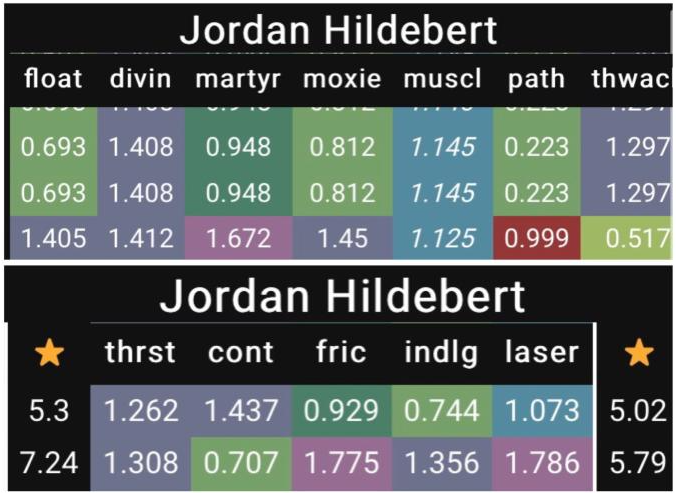Gonna Fly Now: Hall of Fame Week 26

Hosted by SIBR, written by BNN contributors
Jordan Hildebert
Jordan Hildebert got alternated in the season 22 elections, and subsequently became one of the best baserunners that the ILB has ever seen. They ranked 6th in season 23 with 85 stolen bases, but that only paints part of the picture. Subtracting home runs, Jordan got on base 70 times that season, meaning that every time they got on base, you could expect them to steal 1.24 bases. I was also interested in looking at Jordan’s steal efficiency, or how many bases they stole that were able to be stolen (e.g. no runners in front of Jordan). According to my research, Jordan had opportunities to steal 162 bases in season 23, giving them a steal efficiently of 52.47%. Jordan also did this quickly, attempting a steal every 2.44 pitches, often times stealing multiple bases with 1 or 0 pitches thrown.

These numbers are impressive, but they are hindered by the fact that the alternation also tanked Jordan’s hitting stats. Their season 23 OPS of 0.236 was below the league average. If you were to give Jordan a league average OBP of 0.299 and assume the same number of home runs, Jordan would have had 100 steals. Give them their season 22 pre-alternation OBP of 0.325, and you could expect 125 steals. And if you were to give them the 0.348 OBP of season 23 stolen base leader Collins Melon, Jordan would be expected to have 135 stolen bases in total. Still shy of Melon’s 164 mark, but Jordan would have definitely turned more heads.
Sadly, Jordan got voicemail’d early in season 24, and we haven’t seen them since. But I know that they’re in the shadows training, waiting to show the world what a true base runner looks like. This is far from the only reason to vote Jordan Hildebert into the hall of fame; they became a staple power hitter for the Shoe Thieves after a crucial trade. But this is definitely a silly reason that I can support with cherry-picked stats, and those are my favorite reasons of all.
-Paradox
You may have heard about Jordan Hildebert, vexatious pitcher and blocker of consensus. You’ve definitely heard about smol jorn, the funny purple alt. This is about neither of them. The middle of Jordan Hildebert’s oddball career is the least funny, but still worth remembering.
The Spies traded Jordan to the Shoe Thieves for Bennett Bluesky in S14, in the hopes that both players would be better off in each others’ positions—and it worked brilliantly. Jordan was always a slugger (when not at the Wlaffle House) but it was after some late S18 parties that their hitting really took off. At their peak in Season 20, they batted 0.354 (6th in the league) with an OPS of 1.051 (10th).
Unfortunately, Jordan was chomped near the end of S20. By the end of 22, they were well on the way back to their peak when they got hit by the Purple Alt hammer. You know the rest. While smol jorn will always have a place in our hearts, it’s too bad we didn’t get to see more of Jordan Hildebert, power hitter.
-tealdeer
Hiroto Wilcox
Hiroto Wilcox was, alongside Dunlap Figueroa, one half of the dynamic duo of the Tigers rotation, and a large part of why the team won 3 championships, made playoffs 13 times, and ended with a losing record from Season 1 to Season 16. They were a top 10 or top 15 pitcher for most of the Discipline Era, put up one of the best pitching performances ever in Season 12 (26-2 record, 1.34 ERA which is the 6th best all time if excluding Underhanded), and have the second most innings pitched of anyone not named Dunlap Figueroa. Across more than 5000 innings, Hiroto was 20 to 25% better than the average pitcher. Comparable names are Theodore Cervantes, Alexandria Rosales, and of course Dunlap Figueroa. This is as airtight a statistical case as it gets.
But Hiroto gave much more to the team than just fantastic pitching. Since Landry and Moody’s incinerations, Hiroto has been generally thought of as the team’s captain. They are one of, if not the, most beloved Tigers players, and are central to the team’s lore. Hiroto was the Tigers; think of whoever player on your team is the one that most represents them, that everyone knows and puts them in their art or fanfiction – that was Hiroto Wilcox for the majority of the Hades Tigers’ golden years.
-Dargo
Herring Winfield
Early in the Expansion Era, the Shoe Thieves hatched a scheme that can only be described as absurdly hubristic—a three-season plan we dubbed Operation Pitcher of Blood.
(Feel free to imagine the Mission: Impossible theme playing as you read along.)
- Foreshadow Blood Hamburger and bring out our best shadow hitting prospect.
- Foreshadow Tillman Henderson, sending Blood to the mound.
- Shadow our worst batter and bring Tillman into the lineup where he can finally do us some good.
Almost nothing about this plan actually worked. But we got one good thing out of it, and that was Herring Winfield.
After an OK rookie season followed by an Infusion, Herring became the Thieves’ core contact hitter, complementing dinger-oriented Howell Franklin and Jordan Hildebert. I won’t pretend this propelled the Thieves to greatness or even goodness, but let’s see you try batting your way out of the omnishambles that was Expansion-Era Thieves pitching.
Herring peaked at the height of the Ruthlessness era, facing down pitches that flummoxed most batters and turning them into hits. Their best season was S16, when they were 9th in the league in BA (0.311), 11th in OBP (0.334), and 13th in OPS+ (168.2). Overall, Herring earned a solid career wRC+ of 121 and OPS+ of 122—and that’s without considering defense.
Although overshadowed by teammate Richardson “Every Glove Everywhere All at Once” Games, Herring would have been the best fielder on a lot of teams. They were able to make outs of what would normally have been hits given up by our alleged pitching staff. In Season 14, fresh from the Shadows, Herring was already 26th in the league in Outs Above Replacement and 23rd in OAR/1000. Clearly, a recruit with potential. After their infusion, they reached elite status: 11th in OAR and 9th in OAR/1000. We don’t have these stats after S15 but with 1.259-1.349 omni and 1.256-1.383 chase, it’s safe to assume Herring remained a top-tier fielder.
Alas for us, an unexpected trade in the Season 22 elections sent Herring to the Crabs. They were warmly welcomed into their new home, and put in another solid season in Baltimore. And then came Season 24.
The Breath Mints and Fridays were dead. The end of the world loomed. But the Blaseball gods still took the time to inflict smaller tragedies. As the Crabs’ leadoff hitter, Herring was targeted by Consumers fourteen times. By taking those hits, they protected OG Crab and ghost enthusiast Kennedy Loser from Redaction—but their heroism had a cost. Their soul diminished bite by bite until finally they were themselves Redacted on Day 22. But even as they were being systematically chomped into oblivion, they put up some of the best numbers of their career, batting 0.333 for those 22 games. Rest in Redaction, Herring; you went down swinging.
-tealdeer



